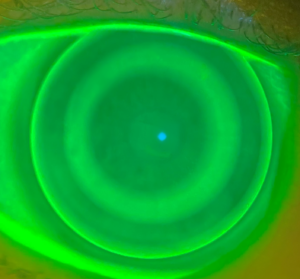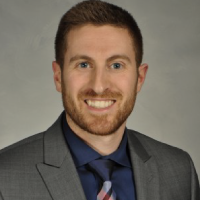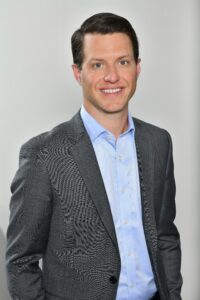sponsored content
July 17, 2023
By Nicholas McColley, OD, MBA
The X-Cel consultants are simply just like the “easy button” of Staples’ advertising. They can save the practice both time and money and streamline the operations of the practice.
 Among the things I’ve discovered since graduating from the Indiana University School of Optometry almost a decade ago is that today there are ever-increasing visual demands on patients. One way to be a successful practitioner in this demanding environment is to provide tailored eye care to meet each of these patient’s individual needs.
Among the things I’ve discovered since graduating from the Indiana University School of Optometry almost a decade ago is that today there are ever-increasing visual demands on patients. One way to be a successful practitioner in this demanding environment is to provide tailored eye care to meet each of these patient’s individual needs.
This is true whether the patient is seeking general eye care or help with treating conditions such as dry eye, glaucoma, and/or macular degeneration. It’s likely even more important for those patients who are being fitted with specialty contact lenses, including orthokeratology lenses to treat myopia.
The fitting process for OrthoK lenses can proceed seamlessly and run smoothly if the key steps are followed and the right resources and tools are utilized. This is what experience has shown and has proven true for ECPs who have been fitting OrthoK lenses for several years, including with the REMLens from X-Cel Specialty Contacts, a highly adjustable, easy-to-fit OrthoK design for the management of myopia.
In our practice, Hancock Eye Associates in Greenfield, Indiana, the OrthoK fitting process starts with the initial conversation with a parent of the patient when using OrthoK to slow a child’s myopia progression. The goal is to make them feel confident in your expertise with OrthoK and to get them on board with the process. This also means the eye care professional should set expectations about the fitting process in the opening conversation and explain the follow-up steps required at this first meeting.
The patient/parent must understand that the first OrthoK lens may not be correct and that a few options may have to be tried before the perfect fit is determined. As the patient’s guide in this process, it’s critical to explain the hurdles involved, the time investment required, the possibility of initial discomfort and any other potential issues that may arise — along with the advantages of treating with OrthoK lenses.
X-Cel Consultants Are the ‘Easy Button’
Fortunately, with the REMLens, X-Cel provides access to experienced consultants who are readily available to help ECPs throughout the design and fitting process. The consultants also will visit ECPs in their offices to help them learn the ins and outs of the fitting process. (Note, too, that for ECPs who want to work at their own pace, X-Cel also offers several online educational tools to help with myopia management.)
For a new OrthoK fitter, our recommendation is that the optimum way to start is the empirical approach — based on experience and observation. This means the ECP needs to gather information from a refraction, keratometry readings (preferably not sim-k’s from a topographer), and topography, and then provide this information to the X-Cel consultants. If possible, this topography should include the HVID, or the white-to-white reading, and then the eccentricity. That also helps the consultant. I also send them the patient’s age and a little bit of a case report. Not a full case history, but a synopsis.
As expected, the better the information the ECP provides the consultant, the better the results and recommendations from the consultant. The consultants are very easy to work with, easy to access, and open to discussion about individual fittings.
In short, the X-Cel consultants are simply just like the “easy button” of Staples’ advertising. They can save the practice both time and money and streamline the operations of the practice.
Yet, there is a slight twist here for me as an ECP. I have generally believed — and practice — with the idea that it’s more effective for my staff to gather the patient information and for me to look at the data and make the treatment decisions.
But with the X-Cel REMLens fitting, it’s the exact opposite. I am there to gather the information, and it’s the X-Cel consultants who are available to guide and lead the decision-making and fitting process. I spend my time and effort gathering the right information, especially on the troubleshooting fits.
This has worked out well for us in our practice. We have a turn rate of about 1.2 or 1.3 lenses to get the fit right. The X-Cel consultants are very accurate, even with the toughest fitting cases.
There really is an X-Cel difference with the team of approximately 14 consultants. They’re all well versed in the entire X-Cel portfolio.
The Fit and Follow-Ups After the Lenses Arrive
Once the lenses come into the office, we do another round of patient education. The first follow-up the morning after the first night, I have the patient wear the contacts in. I do an over-refraction over the top of the lenses and examine the fit with fluorescein, then I remove the lenses and look for corneal damage. Doing this allows me to see the correction from the first night before the cornea reverts to its natural shape.
Then, I follow up a week later in the afternoon, so I can see how long the effect is lasting. I also do a one-month follow-up and then a three-month follow-up. At three months, as long as everything is going well, I order the patient a spare pair. I build that into the cost because inevitably a lens is going to get cracked, lost, broken or whatever the case may be.
It’s always good to have a spare ready to go for the patient, and X-Cel gives us a spare pair discount, which is nice. Then I have the patient return as needed.
Another advantage for ECPs specializing in fitting specialty contact lenses is the elimination of “tinkering,” which many of us in specialty lenses like to do. So, instead of saying, “Let’s flatten this by a step,” or “Let’s do that by 20 microns,” and other small tweaks and adjustments that are time consuming, it’s more effective to leave all of this to the X-Cel consultant. We don’t have as many repetitions as the consultants, and they are just better at making incremental changes to improve the end result.
Start with ‘The Why’ — The Dangers of Myopia Progression
As part of this process, it’s important to keep in mind that parents generally aren’t aware of the prevalence of myopia, even nearsighted parents. What I tell them is, “When you and I were growing up, there wasn’t a way to slow this down, but now we have tried-and-true methods to do it.” I also have a one-sheeter that goes through the different myopia management options on the front, and on the back side it talks about “The Why.”
I start with “The Why” — the increased risk of retinal detachment, glaucoma, and cataracts throughout the lifetime as a result of having a high minus prescription. Often, I will even start the conversation at the parents’ exam. If I see the parents first, I’ll ask, “Do you have any kids?” and if yes, then ask “How old are they?” to determine if they are in the danger zone for myopia progression and make sure we are catching them early enough.
When appropriate, I tell the parents to take the one-sheeter home to read, and I recommend that they bring the kids in for an exam.
Most parents are just astounded that there’s even this technology that can treat myopia because they haven’t heard about it, at least in my area. I know it may be different in other demographics, but it’s a novel concept to most patients I see.
REMLens Calculator Serves as an Online ‘Consultant’
In addition to its consultants, X-Cel offers ECPs an online REMLens Calculator. The calculator can reduce chair time on new fits, or re-fits, and maintain historical patient information through uploadable corneal topography maps, fluorescein images, and video files. REMLens tools also can be used to support replacement lenses of other leading OrthoK lenses, simplifying and eliminating concerns about re-fits.
The REMLens can be prescribed to patients of all ages who are diagnosed with low-to-moderate myopia (up to –5.00D sphere, and up to –1.50D of astigmatism). With an 89% first-fit success rate, REMLens offers ECPs a lens design with a broad range of parameter flexibility and a significant reduction in chair time when fitting empirically from Ks and Rx.
The REMLens also features four independently adjustable fitting zones, five diameter sizes: each with three optic zone options, and the revolutionary Dynamic Edge Profile, providing on-eye comfort in an open and closed eye setting.
Finally, my primary piece of advice is to absolutely avoid making changes the first day you see the patient back in the office after fitting the OrthoK lens. These fits change over the first week, even two or three weeks, so don’t make any changes until at least week one.
Of course, a related benefit is the impact of having satisfied patients, which is a great way to help grow your practice. Satisfied patients are going to trust you because you’ve helped them have healthier eyes, which typically translates into a healthier practice. They refer their kids’ friends and teammates, because they typically see more families than even we do — from school and extracurricular events where being glasses and contact lens-free is beneficial.
Top Tips to Fit X-Cel’s REMLens
By Andrew Biondo, OD
OrthoK lenses have been FDA approved for the temporary reduction of myopia for two decades, yet for many parents and patients, it’s still a relatively new idea. Even for some ECPs, the OrthoK fitting process is unfamiliar and not a common occurrence within their practice.
Here are a few steps and recommendations for fitting OrthoK lenses, particularly the REMLens from X-Cel Specialty Contacts, an adjustable, easy-to-fit OrthoK design for the management of myopia.
- It’s important to achieve a high level of success with patients right out of the gate. If a patient doesn’t respond to the treatment appropriately, skepticism starts to kick in quickly. The REMLens is currently fit empirically, which requires the ECP to collect certain pieces of patient information that can be used to design the lens without having to put the lens on the eye at the initial stage. (Diagnostic fitting sets will be available from X-Cel in the near future.)
- The basic requirements for the initial fitting are the keratometry values and the manifest refraction. Additional information that can be helpful are the horizontal visible iris diameter. This diameter measurement can help cut down on the number of remakes. In addition, the corneal eccentricity is a nice value to have in order to design the lens with the intention of achieving first-fit success.
- When all these parameters are collected, they are entered into X-Cel’s online form, which will automatically calculate lens parameters. That specified lens then can be ordered online and shipped to the ECP’s office for dispensing to the patient.
- A consultation with an X-Cel product expert may come into play during the initial lens design if there are questions regarding any of the parameters. The X-Cel consultation really becomes helpful in cases where troubleshooting the lens fit is necessary.
- If the REMLens is either not centering properly, or if the treatment is insufficient or excessive, then an X-Cel consultant can be called to quickly and effectively troubleshoot any problems. This enables the ECP to get the lens fitting corrected for that patient in a very timely manner. The patient information that should be provided for the consultant may include over-refraction over the REMLens, manifest refraction without the REMLens, any topography measurements, and a description of the centration of the lens while on the eye.
- Another recommendation for anyone who’s new to OrthoK lenses is to be as diligent as possible about getting the best information, the best readings, for the values we input to design these lenses.
- There is a REMLens fitting guide that is extremely comprehensive. It’s a very good resource for ECPs new to the design or new to OrthoK in general to review. And an online calculator works for initial lens selection. The X-Cel consultants will take over in the event troubleshooting is needed, or for any issues that arise after the initial lens has been worn by the patient.
- In the end, the X-Cel consultants are the ECP’s best resource, especially if you’re new to either the REMLens or OrthoK in general. The consultants know the ins and outs of that lens much better than a new fitter will. Before trying to make any significant changes outside of the initial lens selection, or if there are any questions regarding corneal diameter that might impact the initial selection, calling upon the X-Cel consultants can save a lot of chair time and a lot of stress.
 |
Dr. Nick McColley graduated from Indiana University School of Optometry in 2016. After graduation, he moved to Texas and became the Chief Medical Officer of a private multi-state practice system in Texas, Arkansas, and Oklahoma. During that time, he earned his MBA from Texas A&M-Texarkana. He now owns Hancock Eye Associates in Greenfield, Indiana, and his practice is a primary eye care clinic with an emphasis on myopia management/specialty contact lenses, and more recently, aesthetics. Dr. McColley is also a Vision Source Administrator and founded Onward Vision Group, a consulting firm that focuses on private practice efficiency and appraisals/valuations. Dr. McColley is a key-opinion leader for Lumenis and X-Cel Specialty Contacts.
|
 |
Dr. Andrew Biondo owns Kirkwood Eye Associates in St. Louis, a specialty contact lens practice focusing on scleral lenses for irregular cornea and dry eye. They also have a large myopia control practice that utilizes orthokeratology, atropine therapy, and other specialty contact lenses. Dr. Biondo is a consultant to the specialty contact lens industry and speaks internationally on specialty contact lenses and practice management. He is a Fellow of the Scleral Lens Education Society and a past president of the St. Louis Optometric Society. |













